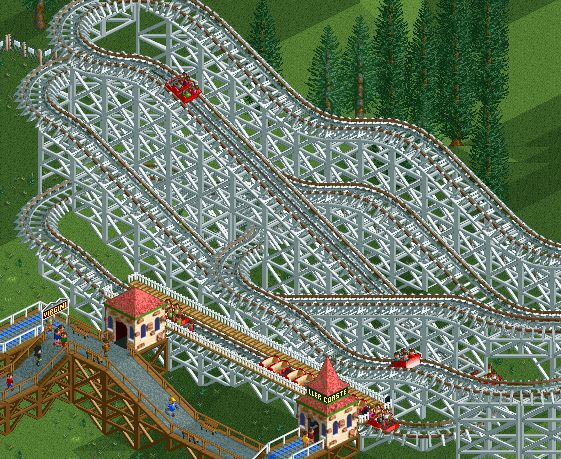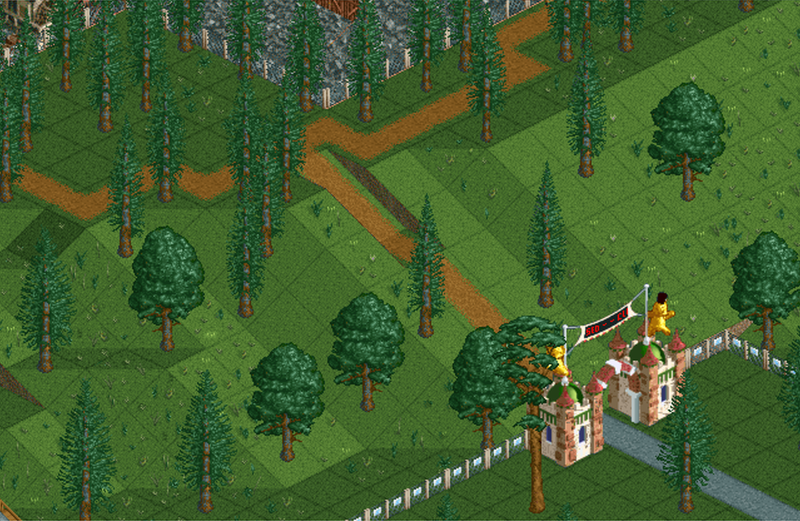
Periodically monitoring each ride's queue time will allow you to optimize the queue's length. It will also depend upon the length of the ride and speed of the chairs.

For example, a long monorail can accept up to 60 peeps at a crack! On the other hand, the Chair Lift handles only 24 passengers, so a queue closer to 10 rather than 20 may be advisable. High capacity rides, like Transport Rides, can swallow up a lot of peeps per train load, so 10 to 20 tiles is best depending upon the type of transport. The efficient handling of queues will allow you to really pack in a lot of rides in a small area. Illustration #6 shows an example of a long queue. Illustration #5 shows an example of a short queue. A good rule of thumb is to never allow more than a 9 minute wait in the queue, otherwise peep happiness levels will begin to suffer. You can do this by selecting the "people" tab on the ride window. Occasionally monitoring a queue's waiting time will help you in determining the optimum length. Personally, I find 7 to 10 tiles works best in an average park. The recommended queue length is between 5 to 15 tiles. Again, it is best to build the ride at least 1 blank tile away from the park pathway. This same entrance/exit booth placement can be employed with most Thrill Rides as well. Illustration #4 shows an alternative method. Illustration #3 shows one method of setting the entrance booth and forming the queue. A long queue will quickly kill off your Ferris Wheel's popularity and profitability. Try to position the Ferris Wheel so as to keep queues limited to just 4 or 5 tiles. This creates very long waiting times in even the shortest of queues. The unloading procedure has the same 2 turns/1 gondola cycle.

It will continue this cycle until all the gondolas are full. The Wheel will then spin twice (the default ride length) and stop to load the next gondola. Two peeps will enter and sit in the first gondola. This Flat Ride is peculiar in the way it loads and unloads passengers. The one notable exception to this 5 to 10 rule is the Ferris Wheel. Peeps won't have to worry about finding the entrance if they want a second go round.

The Dodge 'em car's entrance and exit booths are not on the same side, but the exit is still placed adjacent to the entrance queue. Illustration #2 is an example of a long queue. Illustration #1 shows the Carousel with both booths on the same side. Having adjacent entrance/exit paths encourages repeat ridership, allowing them to immediately re-enter a ride for a second go round. The exit booth should be placed at the front of the ride and adjacent to the entrance queue. It is recommended to place a Flat Ride at least 1 tile away from the park pathway, and to locate the entrance on the back corner of the ride. With this in mind, proper placement of a Flat Ride is important as you will need to consider where to place the ride's entrance/exit booths.

The two strategy guides suggest 5 to 10 tiles, but 7 tiles feels just right for most ride/station arrangements. Most Flat Rides (known as "spin and pukes" in Carnival lingo) work well with a queue of 5 or more tiles. Bearing this in mind, your first consideration when building a ride and positioning the station platform is how long should a queue be? Basically, this will be determined by the type of ride to be placed. Now that happy peeps have queued up for one of your rides, the very last thing you will want is to have that happiness level drop while they are waiting in line.


 0 kommentar(er)
0 kommentar(er)
